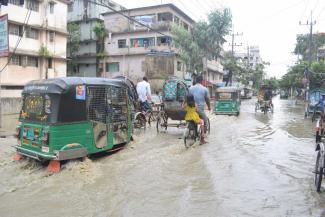Flooding
The city of millions that is being flooded every day
 Rafiqul Islam Montu
Rafiqul Islam Montu
Nurjahan Begum is sitting on a plastic chair in front of her house in a densely populated settlement on the banks of Karnaphuli river in Chittagong. More than half of the chair is submerged under water. Today, hundreds of families in Begum’s neighbourhood were once more trapped in flood water for nearly five hours.
The daily life of many people in Bangladesh’s second largest city is centering around the tides and the rise and fall of the flooding. The sea is 16 kilometres away. Flood water enters the canals of the city through the Karnaphuli river. During high tide, everyone has to stay indoors for five to six hours. All work, errands and other activities have to be finished before the water comes.
More than half of Chittagong is being flooded regularly. According to a survey by the Public Works Directorate, a government agency in Bangladesh, about 69 % of the city is now more or less covered by flood tides.
Another study published in the scientific journal Geophysical Research Letters states that Chittagong lost 2.39 centimetres of land each year between 2015 and 2020. Simultaneously, according to the Intergovernmental Panel on Climate Change (IPCC), sea levels have been rising at a rate of about three millimetres per year since 1993.
Climate refugees face new climate risks
Many of the nearly six million inhabitants of Chittagong came to the city in the last few decades because they were fleeing from the results of other climate disasters happening in the country. Most of them have lost all their properties due to cyclones, river erosion or floods.
So did Nurjahan Begum. Her house on the banks of Meghna River in Daulatkhan, a division in the island district of Bhola, was swept away by a cyclone in 1991. The 60-year-old woman’s life was dominated by climate disasters. They forced her to move a total of 22 times. After the death of her husband and the renewed loss of virtually all her possessions, she came to Chittagong ten years ago with her three children.
Now, her family and many others are facing the impacts of the climate crisis again. Over the past few years, many people have been forced to shift repeatedly, because they live in high-rise areas with more expensive rent during monsoons and move back to low-rent houses in low-lying areas of the city at the end of the monsoon.
Roksana Begum’s family has ten members. They have moved three times in the last two years because of the floods. The 55-year-old migrated to the city to escape the economic hardship in her village. Mohammad Shahjahan also came to Chittagong in search of work when he was 20 years old. Until then, he lived in a village called Dakshin Syedpur on the coast. His family had to shift their house seven times due to river erosion. The place where Shahjahan’s father once constructed their house now lies in the middle of the river Meghna. Shahjahan considered the centre of Chittagong as a safer place but is worried about whether he can continue to live in the city at all.
Daily floodings
The water does not spare the more well-off neighbourhoods either. The World Trade Center, the most important building in the Agrabad commercial area, is now surrounded by floodwater. The city’s most elite residential area, the Chittagong Development Authority (CDA) housing estate, has come up near Agrabad.
The popularity of the area has decreased massively today due to the floods. Abu Kalam is one of the CDA residents. The 70-year-old has invested a lot in his house, the value of which has now dropped significantly. The ground floor is constantly under water. This is the case for the whole area for five to six hours a day. Most people can no longer use their ground floors and have been forced to build new houses elsewhere. The house owners have no chance to rent out their houses in the formerly prosperous area.
Some infrastructure projects are underway to improve the situation. The roads in the most affected areas have been raised by almost one metre – but at high tide the water is still half a metre above the road. Locks are additionally being built at the canal outlets. Rezaul Karim Chowdhury, the acting mayor of Chittagong City, however, pointed out another problem: “Chittagong once had 76 canals. Now it is down to 57. Many canals have been taken over by land grabbers.” He requested the help of the Ministry of Local Government, Rural Development and Co-operatives to bring these canals back under the city’s control.
Chittagong is not the only city facing these problems. In another study published in the journal Geophysical Research Letters, researchers measured the rate of land degradation in 99 coastal cities around the world between 2015 and 2020. In most cities, the land mass is sinking faster than the sea level is rising. If this decline continues, cities will be at risk of flooding much sooner than predicted in most models that focus on sea-level rise. Human activities, especially groundwater extraction, are likely to be the main cause of this decline. Increased monitoring and policies are needed to reduce the rate of deterioration and minimise its impact.
Reference
Wu, P., Wei, M. and D’Hondt, S., 2022: Subsidence in coastal cities throughout the world observed by InSAR.
https://agupubs.onlinelibrary.wiley.com/doi/full/10.1029/2022GL098477
Rafiqul Islam Montu is a Bangladeshi investigative journalist based in Dhaka.
rafiqulmontu@gmail.com
